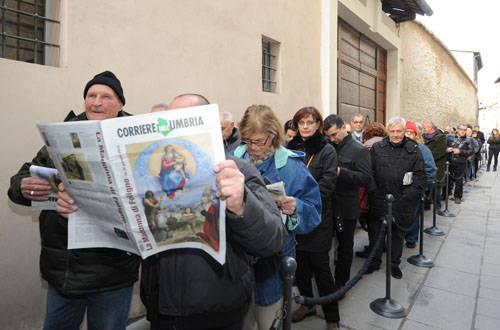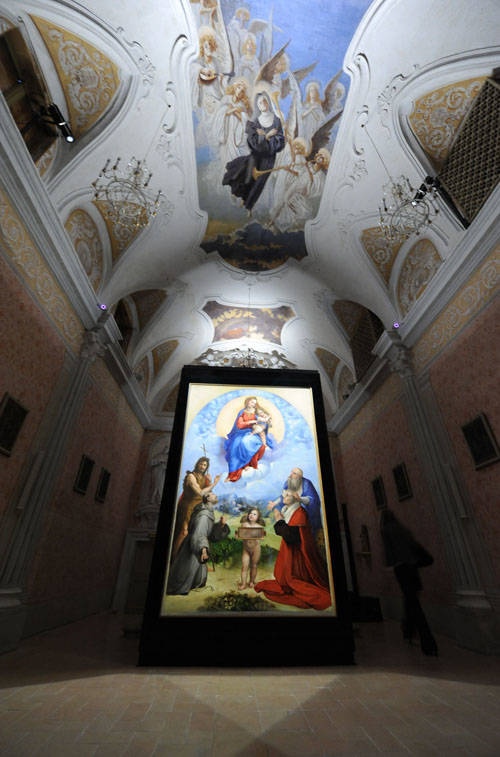Raphael's The Madonna of Foligno Travels Back
The Madonna of Foligno portrays a Sacra Conversazione, a Holy Conversation, the Virgin Mary, seated on clouds and surrounded by angels, is holding baby Jesus and other holy figures (St. Jerome, St. Francis of Assisi, St. John the Baptist and Sigismondo de' Conti) seem to be in conversation, a conversation that excites the curiosity of the viewer who wants to be part of it.
As St. John points to Jesus, he clearly looks out to the viewers, pulling them in, while St. Francis points directly at them and looks at the Christ Child.
Between the Saints there is an angel and behind them there are the towers of Foligno. The iconography in the painting was inspired by a story from the Legenda Aurea (Golden Legend): on Christmas Day, the Virgin and Child are said to have appeared to Augustus before a solar disk, surrounded by angels, and the emperor, refusing to be worshiped as a god, is said to have recognized the greatness of Jesus and consecrated the site of the appearance of the Virgin Mary.
The painting is one of many masterpieces drawn by Raphael, a major representative of the Italian High Renaissance. Dating back to 1511, the painting was executed for Sigismondo de' Conti, chamberlain to Pope Julius II, and it was first painted on a wood panel and later transferred to canvas.
Upon completion, the painting was in the church of Santa Maria in Aracoeli on Rome, where Sigismondo was buried in 1512. In 1565 it was moved by Anna Conti, a descendant of Sigismondo, to the monastery of St. Anne in the town of Foligno itself, and it remained there for more than two centuries... until the arrival of Napoleon (1799) who brought it to Paris. After the Battle of Waterloo, in 1815, the painting was returned to Italy and showcased in the Pinacoteca Vaticana.
Now after two centuries, Eni, Italy's leadingmultinational oil and gas company, has taken Raphael's masterpiece back to Foligno, precisely in the church of the monastery of St. Anne, its previous home.
Before its trip to Foligno, crowds were able to admire the masterpiece at Palazzo Marino, in Rome. 240.000 visitors stopped by to explore its many aspects, relating not only to the work itself, its painting technique, its conservation, and the extraordinary personality of the artist, but also to its history, closely tied with the territory.
The town of Foligno had the wish to have Raffaello' s masterpiece back even for just a short time. Now, Eni and the Vatican Museums have made this dream come true.
Eni has worked hard, in the past few years, to bring art to a wider public: the formula was first developed in 2008 as an opportunity for dialogue and exchange, with the main objective of exhibiting a single work and offering space for new interpretations. The idea is to do things differently, without having a classic exhibition but to display a masterpiece in a unique environment. Each presentation is also supported by several in-depth tools, aimed particularly at children who can learn a lot about and from art.
Thanks to Eni, in the past six years, over 1.2 million visitors had the opportunity of admiring masterpieces such as: Caravaggio’s The Conversion of Saint Paul (2008, over 160,000 visitors), Leonardo da Vinci’s Saint John the Baptist (2009, 180,000 visitors), Titian’s Woman with a Mirror (2010, over 190,000 visitors), Georges de La Tour’s Adoration of the Shepherds and Saint Joseph the Carpenter (2011, 210,000 visitors), and Canova’s Cupid and Psyche with Gérard’s Psyche and Amor (2012, 227,000 visitors).
All these masterpieces from centuries ago continue to enjoy surprising popularity, now, just like back in time, they bring travelers, pilgrims and visitors together in contemplation of their sublime beauty.










































i-Italy
Facebook
Google+
This work may not be reproduced, in whole or in part, without prior written permission.
Questo lavoro non può essere riprodotto, in tutto o in parte, senza permesso scritto.